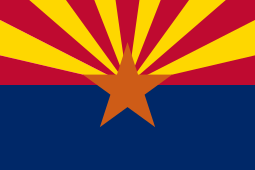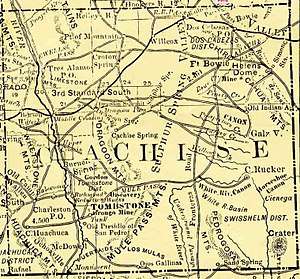Fort Huachuca
Fort Huachuca is a United States Army installation, established on 3 March 1877 as Camp Huachuca. The garrison is now under the command of the United States Army Installation Management Command. It is located in Cochise County, in southeast Arizona, approximately 15 miles (24 km) north of the border with Mexico and at the northern end of the Huachuca Mountains, adjacent to the town of Sierra Vista. From 1913 to 1933, the fort was the base for the "Buffalo Soldiers" of the 10th Cavalry Regiment. During the build-up of World War II, the fort had quarters for more than 25,000 male soldiers and hundreds of WACs. In the 2010 census, Fort Huachuca had a population of about 6,500 active duty soldiers, 7,400 military family members, and 5,000 civilian employees. Fort Huachuca has over 18,000 people on post during the peak working hours of 0700 and 1600 on weekdays.
| Fort Huachuca | |
|---|---|
| Cochise County, Arizona Near Sierra Vista, Arizona in United States | |
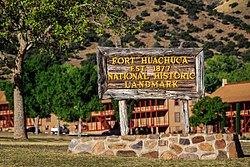 | |
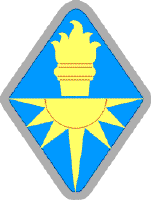 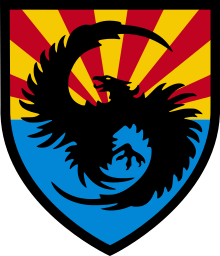  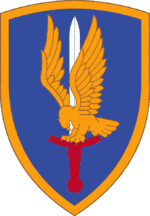  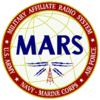 Insignia of units stationed at Fort Huachuca Motto: "From sabres to satellites" | |
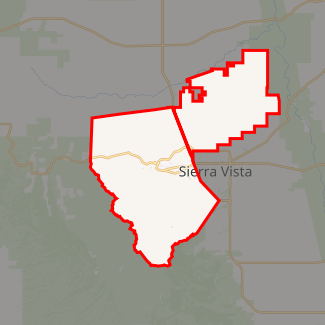
Interactive map outlining Fort Huachuca | |
 Fort Huachuca Location in the United States | |
| Coordinates | 31°33′19″N 110°20′59″W |
| Type | Army Post |
| Site information | |
| Owner | United States |
| Controlled by | |
| Open to the public | Yes |
| Condition | Active |
| Website | Official Website |
| Site history | |
| Built | 3 March 1877 |
| In use | 143 years |
| Battles/wars | Apache Wars 1849–1924 Pancho Villa Expedition 1916-1917 |
| Garrison information | |
| Current commander | |
| Past commanders | List of Past Commanders
|
| Garrison | USAG Fort Huachuca |
| Occupants |
|
| Designations | National Register of Historic Places |
Fort Huachuca | |
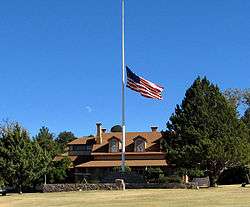 Historic Commanding Officer's quarters | |
  | |
| Nearest city | Sierra Vista, Arizona |
| Area | 76,000 acres (310 km2) |
| Built | 1877 |
| Architect | US Army |
| NRHP reference No. | 74000443 |
| Significant dates | |
| Added to NRHP | 20 November 1974[1] |
| Designated NHLD | 11 May 1976[2] |
The major tenant units are the United States Army Network Enterprise Technology Command (NETCOM) and the United States Army Intelligence Center (USAICoE). Libby Army Airfield is on post and shares its runway with Sierra Vista Municipal Airport. It was an alternate landing location for the space shuttle, but it was never used as such.
Fort Huachuca is also the headquarters of Army Military Auxiliary Radio System (MARS). Other units include the Joint Interoperability Test Command, the Information Systems Engineering Command (ISEC), and the Electronic Proving Ground.
The fort has a radar-equipped aerostat, one of a series maintained for the Drug Enforcement Administration by Harris Corporation. The aerostat is northeast of Garden Canyon and supports the DEA drug interdiction mission by detecting low-flying aircraft attempting to enter the United States from Mexico.
Fort Huachuca contains the Western Division of the Advanced Airlift Tactics Training Center (AATTC) which is based at the 139th Airlift Wing, Rosecrans Air National Guard Base, Saint Joseph, Missouri.
Sierra Vista, which annexed the post in 1971, is located south and east of the post, and Huachuca City is to the north and east.
History
The installation was founded to counter the Chiricahua Apache threat and secure the border with Mexico during the Apache Wars. On 3 March 1877, Captain Samuel Marmaduke Whitside led two companies of the 6th Cavalry and chose a site at the base of the Huachuca Mountains that provided sheltering hills and a perennial stream.[3] In 1882, Camp Huachuca was redesignated a fort.

General Nelson A. Miles controlled Fort Huachuca as his headquarters and against Geronimo in 1886. After the surrender of Geronimo in 1886, the Apache threat was essentially extinguished, but the army continued to operate Fort Huachuca because of its strategic border position. In 1913, the fort became the base for the "Buffalo Soldiers", the 10th Cavalry Regiment, which was composed of African Americans. It served this purpose for twenty years. During General Pershing's failed Punitive Expedition of 1916–1917, he used the fort as a forward logistics and supply base. From 1916–1917, the base was commanded by Charles Young, the first African American to be promoted to colonel. He left because of medical reasons. In 1933, the 25th Infantry Regiment replaced the 10th Cavalry at the fort.
With the build-up during World War II, the fort had an area of 71,253 acres (288.35 km2), with quarters for 1,251 officers and 24,437 enlisted soldiers.[4] The 92nd and 93rd Infantry Divisions, composed of African-American troops, trained at Huachuca.
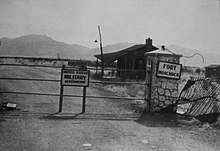
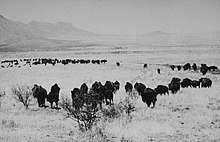
In 1947, the post was closed and turned over to the Arizona Game and Fish Department. However, due to the Korean War, a January 1951 letter from the Secretary of the Air Force to the Governor of Arizona invoked the reversion clause of a 1949 deed. On 1 February 1951 the US Air Force took official possession of Ft. Huachuca, making it one of the few Army installations to have an existence as an Air Force Base.[5] The Army retook possession of the base a month later, and reopened the post in May 1951 to train Aviation Engineers in air field construction as part of the Korean War build up. The engineers built today's Libby Army Airfield. After the Korean War, the post was again placed in an inactive status with only a caretaker detachment on 1 May 1953.
On 1 February 1954, Huachuca was reactivated after a seven-month shut-down following the Korean War. It was the beginning of a new era for this one time cavalry outpost, one which saw Huachuca emerge as a leader in the development of Electronic warfare. The Army's Electronic Proving Ground opened in 1954, followed by the Army Security Agency Test and Evaluation Center in 1960, the Combat Surveillance and Target Acquisition Training Command in 1964, and the Electronic Warfare School in 1966. Also in 1966 the US Army established the 1st Combat Support Training Brigade, whose mission was to train soldiers in specialty of Field Wire and Communication, Telegraph Communications (O5B wired and wireless), Light Tactical Vehicle Drivers, Wheeled Vehicle Maintenance, Food Service and Administration due to the expanding need for these skills in Vietnam. In 1967, Fort Huachuca became the headquarters of the U.S. Army Strategic Communications Command (USSTRATCOM), which became the U.S. Army Communications Command (USACC) in 1973; and U.S. Army Information Systems Command (USAISC) in 1984. It is now known as the United States Army Network Enterprise Technology Command (NETCOM) after the Army decided to drop the 9th Signal Command (Army) designation on 1 October 2011. NETCOM was realigned in 2014 as a subordinate command to United States Army Cyber Command from a Direct Reporting Unit to the Headquarters Department of the Army CIO/G6.[6]
The area is so desolate and barren, an old army description of the fort states, "It is the only fort in the Continental United States where you can be AWOL (absent without leave) for three days and they can still see you leaving"!
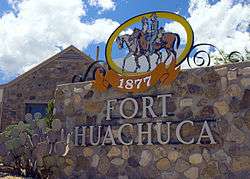
Fort Huachuca was declared a National Historic Landmark in 1976 for its role in ending the Apache Wars, the last major military actions against Native Americans, and as the site of the Buffalo Soldiers.[2][7][8]
In 1980, the 160th Special Operations Aviation Regiment conducted aircraft training exercises from Fort Huachuca in preparation for Operation Honey Badger. This planned rescue attempt was developed to try to rescue captive American personnel in Iran. It was developed in the wake of Operation Eagle Claw's failure. The environment near the fort enabled 160th SOAR pilots to train and simulate flying in the mountainous desert terrain of Iran.
Fort Huachuca is also home to Raymond W. Bliss Army Medical Center, a U.S. Army Medical Department Activity (MEDDAC), namesake Raymond W. Bliss.
It was the location of the 2007 Conseil International du Sport Militaire Military World Games.
Museums
Fort Huachuca has two museums located in three buildings on Post. The Ft. Huachuca Museum[9] takes up two buildings on old Post, its main museum and gift shop (Building 41401) and a nearby spillover gallery called the Museum Annex (building 41305). It tells the story of Fort Huachuca and the U.S. Army in the American Southwest, with special emphasis on the Buffalo Soldiers and the Apache War. The museum is located in a historic building over a hundred years old, with numerous rooms and corridors. Several displays illustrate life on the post during frontier days. Some room dioramas have automatic voice narratives. The gift shop is well-stocked with memorabilia, books, and souvenirs. The Annex bldg across the street (old Post Theater) also has outdoor displays, walkways, sitting areas, and historical statues.
All visitors, military or civilian, are welcome at the Ft. Huachuca Museum free of charge. Civilian visitors without a DOD ID card must pass a criminal background check before being allowed to pass the gate.[10] Foreign visitors must be escorted by serving or retired military personnel. The main gate guard will furnish directions and a post map.
The second museum is The US Army Intelligence Museum, located in the MI Library on the MI school campus (Hatfield Street – Building 62723). The Museum has a collection of unusual historical artifacts including agent radio communication gear, aerial cameras, cryptographic equipment, an Enigma Code machine, two small drones and a section of the Berlin Wall. The Museum's emphasis is on U.S. Army (not civilian or other agency) military intelligence history and includes displays of the organizational development of the Army intelligence specialty. There is a small military intelligence gift shop with customized Fort Huachuca souvenirs. The MI Library and Museum also has a coffee shop called the Enigma Cafe.
Signal Commands
Fort Huachuca has a rich tradition in Army Signal and is currently home to the Network Enterprise Technology Command whose mission is to plan, engineer, install, integrate, protect, defend and operate Army Cyberspace, enabling Mission Command through all phases of Joint, Interagency, Intergovernmental and Multinational operations. It used to be home to the 11th Signal Brigade. The 11th Signal Brigade has the mission of rapidly deploying worldwide to provide and protect Command, Control, Communications, and Computer support for Army Service Component Commanders and Combatant Commanders as well as, Joint Task Force and Coalition Headquarters across the full range of military operations. The "Thunderbirds" constantly train in and around the desert conditions of southeast Arizona. They were deployed to provide signal operations during the 2003 invasion of Iraq. However, on 7 June 2013, the unit cased their colors for the last time on Fort Huachuca and was unfurled on 26 June 2013, at Fort Hood, Texas.
Electronic Proving Ground (USAEPG), a forerunner in the research and development of defense technology, was conducted from and located at Ft. Huachuca for several decades. Currently, the software-defined radios, Wideband Networking Waveform, and the Soldier Radio Waveform, were tested at USAEPG in 2014 for the upcoming network integration evaluation, or NIE 15.2 at Fort Bliss, in 2015.[11]
Military Intelligence
In addition to the US Army Intelligence Center, Fort Huachuca is the home of the 111th Military Intelligence Brigade, which conducts Military Intelligence (MI) MOS-related training for the armed services. The Military Intelligence Officer Basic Leadership Course (MIBOLC), Military Intelligence Captain's Career Course (MICCC), and Warrant Officer Basic and Advanced Courses are also taught on the installation. The Army's MI branch also held the responsibility for unmanned aerial vehicles, due to their intelligence-gathering capabilities, until April 2006. The program was reassigned to the Aviation branch's 1st Battalion, 210th Aviation Regiment, now 2nd Battalion, 13th Aviation Regiment. Additional training in human intelligence (e.g. interrogation, counterintelligence), imagery intelligence, and electronic intelligence and analysis is also conducted within the 111th. The 111th MI BDE hosts the Joint Intelligence Combat Training Center (JICTC) at Fort Huachuca.
People of Fort Huachuca
People who have served or lived at Fort Huachuca:
- Brigadier General Samuel Whitside, founded Camp Huachuca.
- Major General Leonard Wood, Medal of Honor recipient and Chief of Staff of the Army from 1910–1914 (after whom Fort Leonard Wood in Missouri is named).
- Colonel Cornelius C. Smith, Medal of Honor recipient and head of the Philippine Constabulary from 1910–1912. Accepted surrender of Mexican Colonel Emilio Kosterlitzky while stationed at Huachuca in 1913, and was later Huachuca commandant from 1918–1919.
- Bullet Rogan (Negro League Baseball) 25th Infantry Regt
- Cornelius C. Smith Jr., historian of Arizona, California and the Southwestern United States.
- John Henry, played professional baseball for the Washington Senators and Boston Braves from 1910–1918.
- Colonel Sidney Mashbir, Commandant of Allied Translator and Interpreter Section, Military Intelligence Service during World War II.
- General Alexander Patch, highly decorated officer who commanded Army/Marine forces in the Guadalcanal Campaign and later the 7th Army in Europe during World War II.
- General James Gavin (82nd Abn)
- General Robert Sink (101st Abn)
- Lieutenant General Sidney T. Weinstein, one of the driving forces behind reorganizing Army intelligence in late 1970s and 1980s.
- Captain Amadou Sanogo, junta leader in the West African country of Mali, completed intelligence training at Fort Huachuca in 2008.
- Specialist 5 Bobby Murcer, Major League Baseball player, New York Yankees, 1967 – 1969. 1st Training Brigade.
- Luis Robles, goalkeeper for the New York Red Bulls of Major League Soccer, was born at Fort Huachuca in 1984.
- Jayne Cortez, poet, born at Fort Huachuca in 1934.
- Lieutenant General Robert P. Ashley Jr., served as the Commanding General of the Army Intelligence Center of Excellence and Fort Huachuca from April 2013 to July 2015.[12]
- Lieutenant General Scott D. Berrier, served as the Commanding General of the Army Intelligence Center of Excellence and Fort Huachuca from July 2015 to July 2017.[13]
In popular culture
- Captain Newman, MD (1963), starring Gregory Peck as the title character, was filmed at Fort Huachuca.
- The opening sequence of Suppose They Gave a War and Nobody Came (1969) was filmed at Ft. Huachuca. This movie was supported by the 1st Training Brigade. Starred Brian Keith and Tony Curtis.
- Clear and Present Danger (1994), starring Harrison Ford and James Earl Jones, shows Ft. Huachuca equipment being used to intercept a cell-phone conversation of a drug dealer.
- In Scent of a Woman, Al Pacino's character, a retired US Army LTC, refers to having been stationed at Fort Huachuca.
- In the novel A Prayer For Owen Meany (1989) by John Irving, Owen Meany is stationed as a casualty assistance officer at Fort Huachuca during the Vietnam War.
- The novel Ulterior Motives (2009) by Mark Andrew Olsen features Ft. Huachuca as the site where terrorist Omar Nirubi is imprisoned under military control in the United States.
- Going Back to Bisbee, poet and University of Arizona creative writing professor Robert Shelton's 1992 memoir, recounts his time stationed at Ft Huachuca in 1956.
- Second episode of the Lone Target, military reality TV series produced by Discovery Channel, was shot at the fort.
College Football
The Arizona Wildcats football team holds late-summer practice and training camp, in addition to other off-the-field exercises, on Fort Huachuca.[14]
Climate
| Climate data for Fort Huachuca, Arizona | |||||||||||||
|---|---|---|---|---|---|---|---|---|---|---|---|---|---|
| Month | Jan | Feb | Mar | Apr | May | Jun | Jul | Aug | Sep | Oct | Nov | Dec | Year |
| Record high °F (°C) | 81 (27) |
84 (29) |
88 (31) |
96 (36) |
104 (40) |
104 (40) |
105 (41) |
101 (38) |
102 (39) |
99 (37) |
89 (32) |
81 (27) |
105 (41) |
| Average high °F (°C) | 58.8 (14.9) |
61.6 (16.4) |
67.3 (19.6) |
74.1 (23.4) |
81.5 (27.5) |
90.9 (32.7) |
89.3 (31.8) |
87.3 (30.7) |
84.6 (29.2) |
77.3 (25.2) |
67.0 (19.4) |
59.4 (15.2) |
74.9 (23.8) |
| Average low °F (°C) | 33.8 (1.0) |
35.9 (2.2) |
40.8 (4.9) |
46.1 (7.8) |
53.6 (12.0) |
63.0 (17.2) |
65.3 (18.5) |
63.5 (17.5) |
59.7 (15.4) |
51.0 (10.6) |
40.1 (4.5) |
34.6 (1.4) |
49.0 (9.4) |
| Record low °F (°C) | 1 (−17) |
4 (−16) |
18 (−8) |
23 (−5) |
32 (0) |
38 (3) |
44 (7) |
46 (8) |
35 (2) |
24 (−4) |
10 (−12) |
6 (−14) |
1 (−17) |
| Average precipitation inches (mm) | 1.08 (27) |
0.94 (24) |
0.77 (20) |
0.27 (6.9) |
0.23 (5.8) |
0.50 (13) |
3.83 (97) |
3.44 (87) |
1.73 (44) |
0.86 (22) |
0.74 (19) |
1.09 (28) |
15.47 (393) |
| Average snowfall inches (cm) | 1.2 (3.0) |
2.0 (5.1) |
1.1 (2.8) |
0.2 (0.51) |
0.0 (0.0) |
0.0 (0.0) |
0.0 (0.0) |
0.0 (0.0) |
0.0 (0.0) |
0.0 (0.0) |
0.5 (1.3) |
1.9 (4.8) |
6.9 (18) |
| Source: http://www.wrcc.dri.edu/cgi-bin/cliMAIN.pl?az3120. | |||||||||||||
Gallery
- Fort Huachuca in 1918
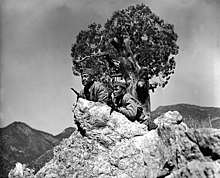 Private William Major and Private Andrew Paxson on patrol of Fort Huachuca in 1942.
Private William Major and Private Andrew Paxson on patrol of Fort Huachuca in 1942.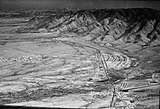 Aerial photograph of Fort Huachuca from the 1950's
Aerial photograph of Fort Huachuca from the 1950's Private Anthony Devlin operating a PPS-4 Radar System in 1956.
Private Anthony Devlin operating a PPS-4 Radar System in 1956. Fort Huachuca in 1970's
Fort Huachuca in 1970's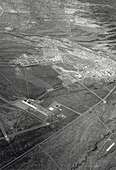 Aerial View of Fort Huachuca in the 1970's
Aerial View of Fort Huachuca in the 1970's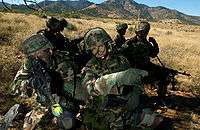 USAF Security Forces on a training exercise at Fort Huachuca.
USAF Security Forces on a training exercise at Fort Huachuca. American Boyd Melson (right), during the 2007 Military World Games, at which he won a gold medal at Ft. Huachuca
American Boyd Melson (right), during the 2007 Military World Games, at which he won a gold medal at Ft. Huachuca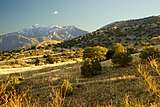 The Huachuca Mountains are the backdrop of several ranges on Fort Huachuca.
The Huachuca Mountains are the backdrop of several ranges on Fort Huachuca.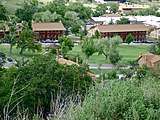 Fort Huachuca Old Post
Fort Huachuca Old Post Huachuca Mountains
Huachuca Mountains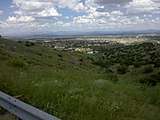 Overlooking Fort Huachuca from Reservoir Hill
Overlooking Fort Huachuca from Reservoir Hill.jpg) Overlooking Fort Huachuca (Old Post) from Reservoir Hill
Overlooking Fort Huachuca (Old Post) from Reservoir Hill
References
- "National Register Information System". National Register of Historic Places. National Park Service. 23 January 2007.
- "Fort Huachuca". National Historic Landmark summary listing. National Park Service. Archived from the original on 2 February 2015. Retrieved 27 September 2007.
- Russell, Major Samuel L., "Selfless Service: The Cavalry Career of Brigadier General Samuel M. Whitside from 1858 to 1902." MMAS Thesis, Fort Leavenworth: U.S. Command and General Staff College, 2002.
- Stanton, Shelby L. (1984). Order of Battle: U.S. Army World War II. Novato, California: Presidio Press. pp. 600. ISBN 0-89141-195-X.
- "Fort Huachuca Army Base in Cochise, Arizona | MilitaryBases.com". militarybases.com. Retrieved 2 March 2018.
- "Fort Huachuca – General History", U.S. Army Intelligence Center and Fort Huachuca, Accessed 2 March 2018
- George R. Adams (January 1976). ""Fort Huachuca", National Register of Historic Places Inventory-Nomination". National Park Service.
- "Fort Huachuca—Accompanying photos, 12 from 1976, 4 from c.1890, 5 from 1975; National Register of Historic Places Inventory-Nomination". National Park Service. January 1976.
- "Fort Huachuca Museum". Retrieved 9 June 2015.
- "Archived copy". Archived from the original on 11 August 2016. Retrieved 13 August 2016.CS1 maint: archived copy as title (link)
- Right frequency for radio testing: Teaming, innovation accessdate=2015-05-28
- Vasey, Joan (6 August 2015). "New commander takes charge of Fort Huachuca during July 31 ceremony". US Army. Retrieved 4 August 2020.
- https://www.afcea.org/event/sites/default/files/files/Berrier%2C%20LTG%20Scott%20D_%20Bio.pdf
- 'Camp Huachuca' success leads to extra day , Arizona Daily Star, Accessed 3 June 2009.
Further reading
- Smith, Cornelius C. Jr.. Fort Huachuca: The Story of a Frontier Post. Fort Huachuca, Arizona: 1978.
External links
| Wikimedia Commons has media related to Fort Huachuca. |
